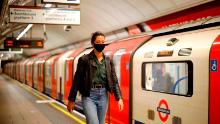[ad_1]
Dr. Anthony Fauci, director of the National Institute of Allergy and Infectious Diseases, said a recent increase in coronavirus cases in a number of states is not necessarily a “second spike.”
“However, when you start to see increases in hospitalization, that’s a surefire situation that you’ve got to pay close attention to,” Fauci told CNN on Friday.
Fauci also said there may not be a so-called second wave of Covid-19 cases as some health experts are predicting.
“It is not inevitable that you will have a so-called ‘second wave’ in the fall or even a massive increase if you approach it in the proper way,” he said.
He advised Americans to follow social distancing recommendations and to continue wearing masks in public, among other CDC guidelines.
Meanwhile former CDC Director Dr. Julie Gerberding, an infectious disease expert who now is an executive vice president at Merck & Co Inc., said Friday that the industry’s collaborative efforts and the 130 vaccines in different stages of production points make her cautiously optimistic the pandemic will end with a vaccine.
“I think the science is on our side, but that doesn’t say anything about the speed, the safety, and the durability and all of the other criteria that have to come into play before we have something that we can count on to give us that population immunity,” Gerberding said.
There are plenty of roadblocks that can arise between lab testing and putting a product out into the public, she said.
“So, a little scientific humility is also an important component of the communication,” she said.
Highs and lows
As of Saturday morning, at least 13 states were showing an upward trend in average daily cases — an increase of at least 10% — over the previous seven days, according to an analysis of Johns Hopkins University data.
But at least 24 states’ average daily cases declined more than 10% over those seven days, the data showed.
This is happening while coronavirus testing in the United States is on the upswing. The number of new tests reported per day in the country has generally tripled since mid-April, according to data collected by the Covid Tracking Project.
New York, once the epicenter of the virus in the US, now has the nation’s lowest rate of transmission, New York Gov. Andrew Cuomo said Friday.
“We were the No. 1 state in terms of infection, … and now we are the last state in terms of rate of transmission. That is because New Yorkers stepped up. They were smart. They were disciplined. They did what they had to do, and we need to stay there,” Cuomo said.
Elsewhere, numbers have been climbing.
Arkansas Gov. Asa Hutchinson said Friday that the state had a record number of cases reported in the previous 24 hours.
In some places, spikes in cases have delayed reopenings.
Oregon Gov. Kate Brown put a seven-day pause on moving forward with reopening in light of a rise in cases that followed loosening of restrictions.
“This is essentially a statewide yellow light,” Brown said Friday during a news conference.
And in Baltimore, after an 8% increase in cases since June 5, Mayor Bernard C. Young announced Friday that the city would not be moving into phase 2 of reopening with the rest of the state.
“Let me be crystal clear with everyone: I, more than almost anyone, would love to see that Baltimore City is open and safe, but that simply is not what the data is telling us at this time,” the mayor said.
Officials at the CDC said Friday they are not confirming striking increases in hospitalizations related to the virus across the country, but that they will “monitor very closely,” Dr. Jay Butler, CDC’s deputy director for infectious diseases, said during a call with reporters.
Most Americans are following guidelines
Most Americans are adhering to CDC guidelines introduced to mitigate the pandemic, according to a survey from the CDC.
In the survey released Friday, close to 80% of Americans surveyed nationwide said they had self-isolated last month and 85% of New Yorkers said they had when the survey was conducted in May.
Nationwide, 74% of those surveyed said they wore face coverings in public either always or often and those in the hard-hit cities of New York and Los Angeles said they did so about 90% of the time.
And 84.3% of those surveyed believed their state’s mitigation strategies were the right balance or even not restrictive enough, the survey team, led by the CDC’s Michael Tynan, said in the agency’s weekly report.
“Most adults reported they would not feel safe if government-ordered community mitigation strategies such as stay-at-home orders and nonessential business closures were lifted nationwide at the time the survey was conducted, although a minority of these adults who did not feel safe wanted these restrictions lifted despite the risks,” the team concluded.
CNN’s Maggie Fox, Dave Alsup, Shelby Lin Erdman and Jen Christensen contributed to this report.
[ad_2]
Source link




